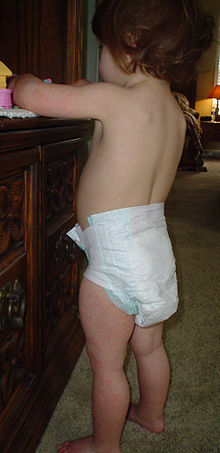
Back طفح وردي Arabic Розеола инфантум Bulgarian রোসেওলা Bengali/Bangla Rosèola infantil Catalan Šestá nemoc Czech Суя хĕрлĕ шатра CV Tredagesfeber Danish Drei-Tage-Fieber German Roséola Spanish Roseool Estonian
| Roseola | |
|---|---|
| Other names | Exanthema subitum,[1] roseola infantum,[1] sixth disease,[1] baby measles, rose rash of infants, three-day fever |
 | |
| Roseola on a 21-month-old girl, displaying characteristic rash | |
| Specialty | Infectious disease |
| Symptoms | Fever followed by rash[1] |
| Complications | Febrile seizures[1] |
| Usual onset | Before the age of three[1] |
| Duration | Few days[2] |
| Causes | Human herpesvirus 6 (HHV-6) or human herpesvirus 7 (HHV-7)[1] |
| Diagnostic method | Typically based on symptoms[1] |
| Differential diagnosis | Measles, rubella, scarlet fever[1] |
| Treatment | Supportive care[1] |
| Prognosis | Generally good[1] |
Roseola, also known as sixth disease, is an infectious disease caused by certain types of human herpes viruses.[2] Most infections occur before the age of three.[1] Symptoms vary from absent to the classic presentation of a fever of rapid onset followed by a rash.[1][2] The fever generally lasts for three to five days, while the rash is generally pink and lasts for less than three days.[1] Complications may include febrile seizures, with serious complications being rare.[1][2]
It is caused by human herpesvirus 6 (HHV-6A, HHV-6B) or human herpesvirus 7 (HHV-7).[1] Spread is usually through the saliva of those who are otherwise healthy.[1][2] However, it may also spread from the mother to baby during pregnancy.[1] Diagnosis is typically based on symptoms and does not need to be confirmed with blood tests (PCR or antigen).[1] Low numbers of white blood cells may also be present.[1]
Treatment includes sufficient fluids and medications to treat the fever.[1] Nearly all people are infected at some point in time.[2] Males and females are affected equally often.[1] The disease may reactivate in those with a weakened immune system and may result in significant health problems.[2]
The disease was first described in 1910 while the causal virus was determined in 1988.[1] The name "sixth disease" comes from its place on the standard list of rash-causing childhood diseases, which also includes measles (first), scarlet fever (second), rubella (third), Dukes' disease (fourth, but is no longer widely accepted as distinct from scarlet fever), and erythema infectiosum (fifth).[3]
- ^ a b c d e f g h i j k l m n o p q r s t u v w Stone, RC; Micali, GA; Schwartz, RA (April 2014). "Roseola infantum and its causal human herpesviruses". International Journal of Dermatology. 53 (4): 397–403. doi:10.1111/ijd.12310. PMID 24673253. S2CID 2652000.
- ^ a b c d e f g Campadelli-Fiume, Gabriella (1999). "Human Herpesvirus 6: An Emerging Pathogen". Emerging Infectious Diseases. 5 (3): 353–366. doi:10.3201/eid0503.990306. PMC 2640789. PMID 10341172.
- ^ Feder, Henry M.; Grant-Kels, Jane M. (2008), Schlossberg, David (ed.), "Classic Viral Exanthems", Clinical Infectious Disease, Cambridge: Cambridge University Press, pp. 135–140, doi:10.1017/cbo9780511722240.020, ISBN 978-0-511-72224-0, retrieved 2022-01-04
© MMXXIII Rich X Search. We shall prevail. All rights reserved. Rich X Search